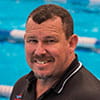Use Your Head to Fix Your Body Position and Alignment
In both long- and short-axis strokes, start with your head position
Your body position, which is affected by your head position, will determine how fast you can swim.
Minimizing drag is the name of the game. The angle of your body in the water creates drag and you must burn energy to overcome drag. The less horizontal your bodyline is, the more drag you create as the larger your cross-sectional area is. The goal is to be as narrow and horizontal on the water as possible. This is the foundation of your stroke, so all the energy you put into swimming is maximized when you have a good body position.
Long-Axis Strokes
Freestyle and backstroke are long axis strokes in that your body rotates on its long axis—the imaginary line from the top of your head straight through your spine. Swimming technique evolves as our understanding of what makes us move through the water changes. For example, you might have been taught to swim freestyle keeping the waterline at the top of your goggles, which is a higher head position than what’s taught today.
- The physics—The center of your chest is your center of buoyancy. It’s where the lungs are, and they’re full of air so they float. Think of your chest as the center of a seesaw: when one end goes up, the other goes down. When you lift your head, your hips tend to sink. If you try to compensate for this by developing a powerful kick, your kick is then providing lift to your hips more than it’s propelling you forward.
- The fix—Experiment with your ideal head position—one that keeps your hips at the top of the water. Head all the way up is all the way wrong and chin all the way down on your chest is all the way wrong. You’re going to fall somewhere in between that, but don’t make it random. Do 25s with different head positions. The best one will be determined by your hip position, especially when you’re not kicking. This may require you to tilt your pelvis back slightly to get your back flat on the water.
- Variation for backstroke—In backstroke, again, it starts with the head. Looking all the way back at the wall is bad and so is putting your chin on your chest. Experiment with different head positions to find out what’s fastest for you. A good head position will still require you to tilt your pelvis forward to bring your feet to the top of the water and achieve the kayak shape with your body needed for fast backstroke.
Short-Axis Strokes
Breaststroke and butterfly are the short-axis strokes, in that you’re pivoting on a lateral axis through your center of buoyancy. Both strokes have also gone through an evolution and none more than breaststroke. Years ago, it was illegal for your head to submerge during the stroke. Just as with freestyle and backstroke, a high head position caused the hips to sink. For butterfly, breathing every stroke was discouraged as it caused the hips to sink. Although breaststroke and butterfly have undulation, spinal alignment is still key.
- The physics—Keeping the head up in breaststroke creates the same imbalance and dropped hips that it does for freestyle because of the seesaw effect created by your lungs.
- The fix—When you breathe, don’t throw your head up and down like you’re at a heavy metal concert. Minimize unnecessary neck flexion by keeping your spine in line. There are many variations of the stroke and different techniques associated with fast breaststroke, but all share one thing in common and that’s keeping your head in line with your spine.
- Variation for butterfly—As with breaststroke, throwing your head up and down as though you’re bobbing for apples is not effective. Keep your neck in line with your spine. Use your hand-entry kick to get your hips up. Drive your chest forward on the entry rather than down. Drive your knees a little deeper to help keep you flatter on the water and so that less energy is being used for up and down and more is directed at moving you forward.
Good spinal alignment starts with your head. But don’t stop there when it comes to your aquatic posture. Where your chest and hips are also plays a role. Everyone is different so your ideal position is a matter of experimentation. Remember, what feels normal or easier isn’t always what’s best or fastest. Get feedback from a coach or knowledgeable teammate to help you find the right head and body position.
Categories:
- Technique and Training
Sign Up for Great Swimming Content
















